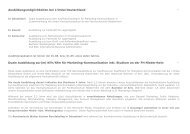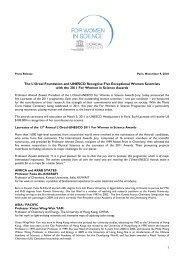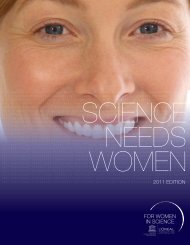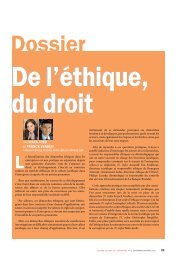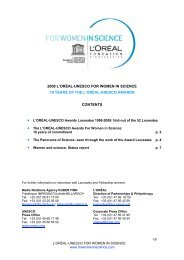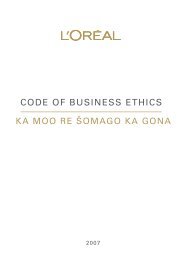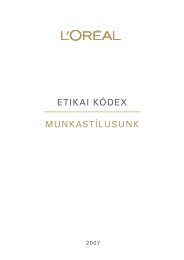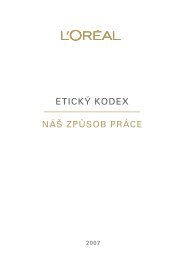Create successful ePaper yourself
Turn your PDF publications into a flip-book with our unique Google optimized e-Paper software.
highlights<br />
Demonstrating the efficacy of natural and organic<br />
cosmetics ingredients is a key objective.<br />
THE “BEAUTYOMICS” AND ETHICAL BEAUTY<br />
OF TOMORROW<br />
Cellular and then molecular biology has enabled<br />
researchers to study the skin and hair as living<br />
organs, made up of cells whose functions change<br />
under the effect of ageing, stress and the<br />
environment. The advent of “omic” tools has<br />
thrown new light on ageing, hair loss and repair or<br />
regeneration. The work of L’Oréal researchers on<br />
the skin genes involved in ageing has enabled the<br />
decoding of a family of proteins that determine skin<br />
youthfulness and the selection of active ingredients<br />
that can re-express youthful characteristics. Another<br />
team has succeeded in enriching or impoverishing<br />
in vitro an epidermis of stem cells to correct the<br />
damage caused by the effects of sun or age. Newgeneration<br />
anti-ageing skincare products have<br />
been launched at the start of 2009.<br />
Japan: creation of a high technology department.<br />
China: creation of a biology and reconstructed<br />
skin unit.<br />
Brazil: creation of a research and development unit<br />
in Rio de Janeiro.<br />
By adopting an eco-design policy, the group has<br />
been able to commit to the non-use of animals<br />
to test the harmlessness of its products without<br />
putting the well-being of future generations at risk.<br />
INVENTING A CENTURY OF BEAUTY<br />
From March 2009, a European directive will prohibit<br />
the sale in Europe of cosmetics whose ingredients<br />
have been tested on animals. This ban will apply to<br />
all testing in 2013. To guarantee its ability to<br />
innovate without making any safety concessions,<br />
L’Oréal Research anticipated this trend 30 years<br />
ago, by developing a safety testing strategy based<br />
on predictive methods. These are based on data<br />
built up over the past 100 years: knowledge of<br />
ingredients, test results, the development of in vitro<br />
and in silico tools, the correlations established<br />
between these results and clinical studies, the<br />
sharing of data with the group’s suppliers and<br />
players from other industries as part of European<br />
partnerships, and above all scientific advances.<br />
To control the impact of products on the planet, the<br />
L’Oréal laboratories have put in place an eco-design<br />
approach which incorporates — from the ingredient<br />
selection stage — indicators about the traceability<br />
of ingredients, what happens to them in water and<br />
air, and their impact on biodiversity. Suppliers of raw<br />
materials are involved in this process, and are<br />
required to comply with naturalness criteria from the<br />
ingredient design stage.<br />
In <strong>2008</strong>, the group created a laboratory specialising<br />
in ecotoxicity at Aulnay-sous-Bois (France), which<br />
uses methods to evaluate impact on ecosystems.<br />
France: creation of two laboratories, specialising<br />
in ecotoxicity and high-throughput performance<br />
evaluation of new active ingredients.<br />
Europe: at the end of <strong>2008</strong>, L’Oréal pre-registered<br />
all its chemical substances covered by European<br />
REACh regulations (“Registration, Evaluation,<br />
Authorisation and Restriction of Chemicals”).<br />
In the evaluation of raw materials, the absence<br />
of environmental impact is a priority.<br />
25



